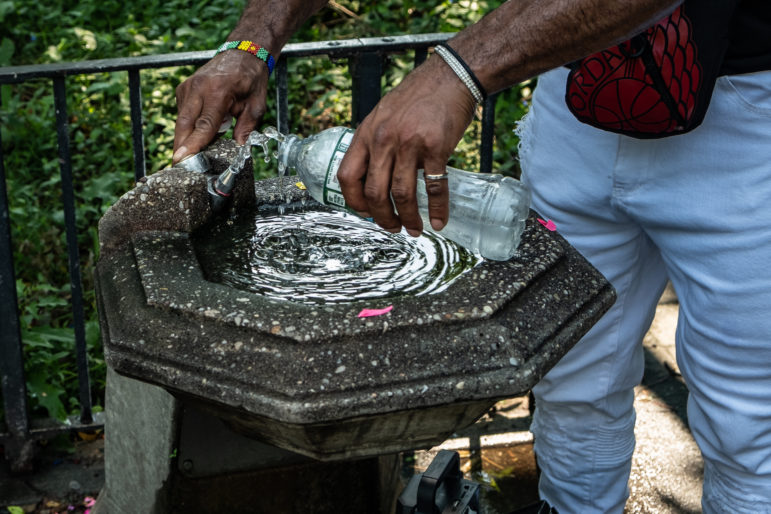Environmental advocates say New York’s proposed new rules don’t go far enough to limit the contaminants, which can lead to reproductive issues and developmental delays.

Adi Talwar
A drinking fountain at Mount Hope Playground in the Bronx.
New York State’s Department of Health proposed reducing the maximum levels of so-called “forever chemicals” allowed in drinking water in the State Register released Wednesday. In its explanation for the recommendation, the DOH wrote that the current level is not protective of public health—though environmental groups argue it’s still not enough to limit the contaminants, which can lead to reproductive issues and developmental delays.
The proposal relates to 23 contaminants, including perfluorohexanesulfonic acid, perfluoroheptanoic acid, perfluorononanoic acid and perfluorodecanoic acid—four of six chemicals collectively called PFAS6. These substances are man-made chemicals used as a coating in some consumer products and packaging, non-stick cookware and firefighting foam.
Long-term exposure to the substances, including in drinking water, has been shown in studies to lead to reproductive issues, thyroid and kidney problems, developmental delays and increased cancer risk, among other health issues, according to the EPA.
For those four specific chemicals, there’s currently no maximum level above which remedial action is required; the state proposes setting that level to 10 points per trillion (ppt). The department also recommends that the combined maximum levels of all six chemicals be no more than 30 ppt. “The 10 ppt standard, while health protective, will allow for a total concentration of upwards of 60 ppt, which is not sufficiently health protective,” the DOH wrote. The recommendations are open for public comment until Dec. 5.
On June 15, President Joseph Biden released a plan to reduce PFAS pollution and said that the EPA would be releasing new guidelines this fall—the first time since 2016—on allowed levels of these chemicals in drinking water. That same day, the EPA published interim guidelines for PFOA and PFOS, which were 10 times lower than what New York’s DOH proposes.
The DOH, though, notes that those levels are only a goal and not necessarily what the actionable levels will be. Following that announcement, the agency released a statement saying it was currently evaluating the levels of contaminants.
“While the new interim Health Advisory Levels provide additional guidance on PFAS in drinking water, New York continues to advocate for an enforceable national drinking water standards for PFOA and PFOS and looks forward to EPA’s release of proposed standards later this year,” it said.
In the state register this week, the agency noted it was no longer waiting for those federal guidelines.
“Waiting for the USEPA to set a new MCL was impractical due to the prevalence and concerns surrounding these compounds combined with the timeframes required under the Safe Drinking Water Act,” the agency wrote.
Some environmentalists argue that the new recommended standards are not enough to limit the health impacts of the chemicals, and are higher than the guidelines other Northeastern states allow. For instance, Maine and Massachusetts allow for a combined maximum of 20 ppt.
“Under this proposal, at least half a million New Yorkers will continue to drink water contaminated with PFAS, even though EPA has confirmed there is no safe level of exposure to some of these toxic chemicals,” Rob Hayes, the director of clean water at Environmental Advocates NY, said in a statement.
Also this week, Gov. Kathy Hochul signed legislation removing a statute of limitations applied to water polluters. Local water authorities now have an additional year and a half from Oct. 5 to pursue recovery of costs to treat water contaminated longer than three years ago. It also expanded the definition of “emerging contaminant.”
Increased drinking water scrutiny comes just a month after errant lab results showing levels of arsenic in the drinking water at Manhattan NYCHA property Jacob Riis Houses led to residents buying bottled water and mistrusting the administration’s assertions that the water is safe.
While the city offers kits to test for lead in drinking water, identifying additional contaminants in water falls on the tenant or homeowner—and it can be costly. (Read our guide on how to test for lead and other pollutants.)
Liz Donovan is a Report for America corps member.








